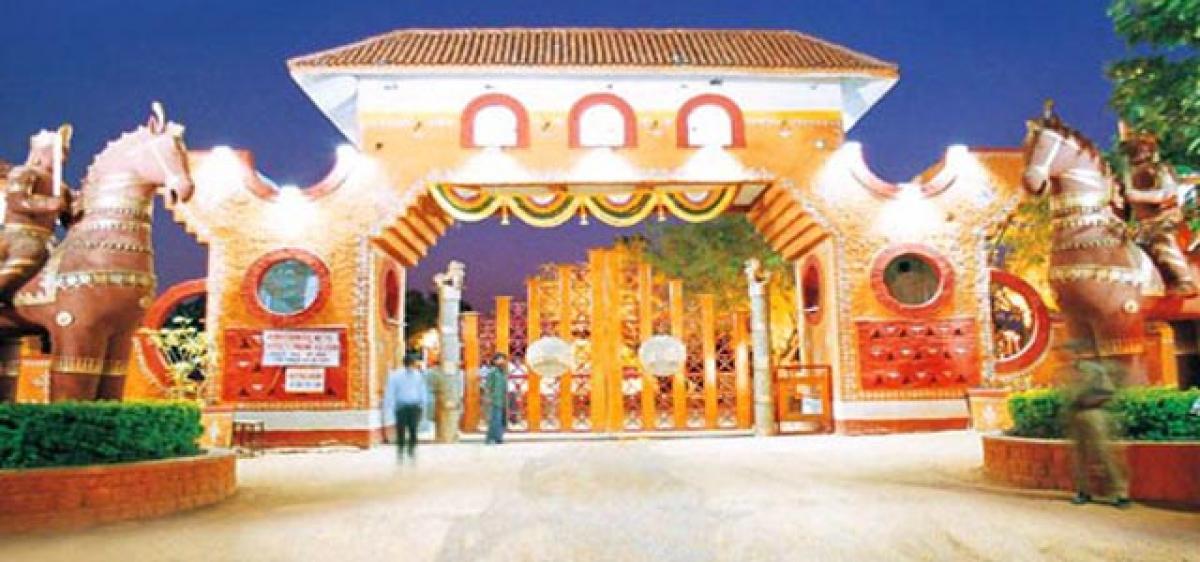Live
- BJP MP candidate Bharat Prasad visited the student who tried to commit suicide
- PM’s popularity in the fast lane: Autos with 'Har Dil Mein Modi' slogan spotted across Delhi
- Delhi-based political parties are like East India Company: Sukhbir Badal
- Golf: Diksha moves into Top-20 at South African Women’s Open
- KCR lashes out against BJP and Congress for destroying Telangana
- Dairy Science students visited the Milk cooling plant
- Moody feels Pant ahead in keepers’ race for T20 WC squad; Srikkanth picks Rahul over Samson as reserve keeper
- Thanking voters for extending 'unparalleled support' to NDA, PM Modi says second phase 'too good'
- Natural Relief for Menstrual Cramps: Beetroot Juice Recipe
- Asha Worker died in a road accident
Just In

Shilparamam, in association with South Zone Cultural Center, Tanjavur is presenting an array of cultural festivities to ring in the New Year. Hundreds of performers from all over India came down to perform during the two day event (March 27 and 28).
Shilparamam, in association with South Zone Cultural Center, Tanjavur is presenting an array of cultural festivities to ring in the New Year. Hundreds of performers from all over India came down to perform during the two day event (March 27 and 28).
Elaborating on the spirit of spring, the dances embody the colour, vigour and exhilaration of the season. Here is a low down of the amazing dancers performed during the Ugadi celebrations at Shilparamam.
The Chhau Dance, from Jharkhand, a fusion of classical Indian dances is an all-male performance that celebrates spring. The dance is a vigorous, athletic dance of martial arts and is based on the stories from Hindu epics, Puranas and other Hindu literature.
Males beat on a tambourine shaped drum with sticks and rhythmically moving to synchronize the chime of their anklets with the “Dappu.” The Dappu dance from Andhra Pradesh, often performed in large groups is subject to steps chosen by the performers each time.
Charkula dance from Uttar Pradesh is popular in Braj region. Legend says that Radha’s mother carried the Charkula or oil lamps on her head to announce her birth. Another story says that it is symbolic of the Govardhan hillock that Krishna lifted to shelter the citizens of Brindavan from the wrath of Indra.
The third day after Holi, the birthday of Radha, is the traditional day of performance for the dance. Women perform the dance with 108 oil lamps on their heads to the songs from Ras Leela. Despite the restrictions of weight on their heads the dancers gracefully glide, bend and pirouette.
Phag/Phagun dance from Haryana expresses the joy of spring. While, both men and women the dance together, sometimes only the men perform the dance. Ghoomar performed by girls of the areas bordering Haryana is a circular dance that has an increasing tempo. The songs are full of satire and humour and refer to contemporary events.
Veerabhadra (Veeragase) dance performed in praise of Veerabhadra narrates the story of Lord Shiva and Daksha. The dance involves two to six members with some playing the music, one singer narrating the story and others piercing their bodies with long needles. While women do not perform in the religious performances, stage/non-religious performances see the involvement of women.
Thappatam dance from Tamil Nadu uses a handheld drum (Thappu) similar to Dappu dance. The pulsating, entertaining drum music celebrates life. Kalaripayattu one of the most popular martial arts from Kerala is one the oldest and most scientific of its kind in the world. Kalaripayattu trains the body and mind and keeps them agile and supple.
Taandi and Chancheri dances performed by both men and women come from Uttarakhand. Badai dance performed during birth, marriages and festivals is from Bundelkhand region of Madhya Pradesh.
The Rathwa tribal dance from Gujarat performed during Holi, also known as Kavant festival lasts for five days. The colourful dance involves vigorous whirling of the dancers and symphony that is an expression of the community’s cultural identity and their attachment to nature.
Bhangra is one of the most popular forms of synchronised, vigorous group dances from Punjab. Performed on most occasions, it celebrates life. The group from Punjab is also performing Jindua. Each of the pairs from the group performs in the foreground while the other pairs of the group dance in the back. Malwai Giddha, again from Punjab, involves playing instruments like the chimta or tongs and dancing rhythmically.
Ugadi will flag off with traditional Panchanga Sravanam by Sri Sagi Kamalakara Sharma (Vedic astrologer and consultant) followed by “Ruthu Shobha” Bharatanatyam performance by Smitha Madhav and her students. No festivities of Ugadi are complete without the taste of Ugadi Pachchadi. Shilparamam will serve this specialty to its visitors from 10.30am on March 29.

© 2024 Hyderabad Media House Limited/The Hans India. All rights reserved. Powered by hocalwire.com







